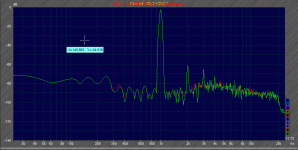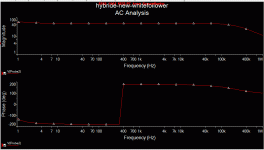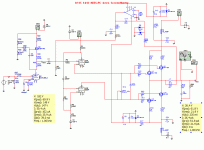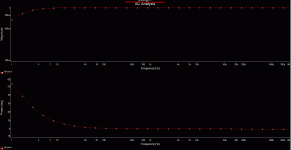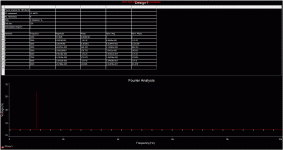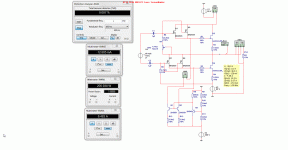Hi Duncan,
Yes, thanks for that link. Gate drive is clear to me now.
As for the use as an AC switch, I was wondering what the channel leakage would be when reverse-biased? Can these devices withstand reverse bias? A 'normal' FET with an antiparallel diode can never be reverse biased since the diode would conduct, but that's not the case here.
jan didden
Reverse biasing of the channel would result into a negative Vds. The JFET would start conducting again if Vgd (not only Vgs) is sufficiently high. It will behave like the drain is the source. If the device's junction structure is fully symmetrical, it is even possible to exchange source and drain without affecting it's characteristics. It is a well known feature from some small signal JFETs like the BF245.
So for an AC switch, it is important to have a sufficient low potential on the gate to avoid channel conduction due to Vgd modulation.
Reverse biasing of the channel would result into a negative Vds. The JFET would start conducting again if Vgd (not only Vgs) is sufficiently high. It will behave like the drain is the source. If the device's junction structure is fully symmetrical, it is even possible to exchange source and drain without affecting it's characteristics. It is a well known feature from some small signal JFETs like the BF245.
So for an AC switch, it is important to have a sufficient low potential on the gate to avoid channel conduction due to Vgd modulation.
Let me see if I get that. For a normally-off device, the gate should be negative enough wrt the drain, not to start conduction at the most negative Vds expected, assuming that the Vgs can handle it?
jan didden
Let me see if I get that. For a normally-off device, the gate should be negative enough wrt the drain, not to start conduction at the most negative Vds expected, assuming that the Vgs can handle it?
jan didden
That's correct Jan. It also holds true for a (regular) normally-on JFET. SemiSouths normally-off variant seems to be developed for enhanced compatibility with existing MOSFET drive circuitry only.
Getting the gate potential as low as possible also reduces Cgs and Cgd.
Last edited:
As I see it the gate of a normally off JFET keeps conduction off because the source-drain channels are narrow and fully depleted, having gates each side of the conduction path. Forward biasing the gate reduces the diode depletion regions and increases channel conduction. At high bias the diode will inject carriers just like a bipolar.
John
John
As I see it the gate of a normally off JFET keeps conduction off because the source-drain channels are narrow and fully depleted, having gates each side of the conduction path. Forward biasing the gate reduces the diode depletion regions and increases channel conduction. At high bias the diode will inject carriers just like a bipolar.
John
Right. I'd guess that with normal operation regimes it wouldn't be necessary to drive it so hard that the diodes would open up. Or maybe with pulse drive to charge up the capacitances quickly.
I need to get one of these things!
jan
I need to get one of these things!
You will when you come to visit in October. In the meantime, you will want
to note that there is also a Gate leakage current figure of a few micro-amps
as a function of temperature and Vds, even in the depletion mode devices.
On a good day they are 1 uA or less, and on a marginal part can approach
100 uA. As a result, selection and burn-in is a good idea for parts driven
linearly by a high DC impedance.
I haven't driven these hard enough to see significant forward bias diode
current yet.
You will when you come to visit in October. In the meantime, you will want
to note that there is also a Gate leakage current figure of a few micro-amps
as a function of temperature and Vds, even in the depletion mode devices.
On a good day they are 1 uA or less, and on a marginal part can approach
100 uA. As a result, selection and burn-in is a good idea for parts driven
linearly by a high DC impedance.
I haven't driven these hard enough to see significant forward bias diode
current yet.

Thank you Nelson, that's great!
Have you considered driving these devices from something like a small-signal source follower?
jan didden
Have you considered driving these devices from something like a small-signal source follower?
You mean like the one in our preamp? Actually, it seems to get along fine
with a few hundred ohms. If a "girlie-man" preamp can't manage that, a
Jfet like a 2SJ74 and/or 2SK170 buffer would be more than adequate.
Speaking of our preamp, you'll be interested to know that on the XP30 I
asked Wayne for 2 sets of outputs whose relative levels can be adjusted for
all the poor guys trying to make "passive bi-amp" systems work properly
and also low impedance, high swing, high gain outputs.
The latter are designed to drive follower stages directly to a couple hundred
watts, so the preamp serves as an amplifier front end.
Saves me a lot of work.
[snbip]Speaking of our preamp, you'll be interested to know that on the XP30 I asked Wayne for 2 sets of outputs whose relative levels can be adjusted for all the poor guys trying to make "passive bi-amp" systems work properly and also low impedance, high swing, high gain outputs.
The latter are designed to drive follower stages directly to a couple hundred
watts, so the preamp serves as an amplifier front end.
Saves me a lot of work.

Sounds like an excellent move. People with F5-type low gain power amps will more than welcome this option.
jan didden
They are now officially available. 
SiC JFETs target high-end audio
15% lower cost; high linearity, low distortion; available packaged or in die form
Publication date: 24 August 2011
An externally hosted image should be here but it was not working when we last tested it.
SemiSouth Laboratories, Inc., the leading manufacturer of silicon carbide (SiC) transistor technology for high-power, high-efficiency, harsh-environment power management and conversion applications, has launched a new family of low cost SiC JFETs with very good linearity targeted at high-end audio applications.
Types SJEP120R100A and SJEP120R063A are claimed to offer a very good linearity and best-in-class distortion. Compatible with standard gate driver ICs, both versions feature a positive temperature coefficient for ease of paralleling; extremely fast switching with no’tail’ current at up to a maximum operating temperature of 150 degC and a low RDS(on) max of 0.100 Ω and 0.063 Ω respectively. Devices are available in TO-247 packages; the 100 mΩ part is also available in die form for integration into modules.
Comments Nelson Pass, founder of leading audio amplifier manufacturer Nelson Pass, Inc., “Over the last forty years I have greatly appreciated the qualities of lower power JFETs in audio circuits, and experimenting with the few examples of ‘unobtainable’ power JFETs has convinced me of their great potential. With the new SiC power JFETs from SemiSouth, this potential has been realized in reliable linear power amplifiers. In push-pull topologies, they exhibit a 50% to 70% improvement in distortion, and in single-ended circuits the improvement has been nearly ten-fold. Currently we profitably produce a small high-end audio amplifier using the SJEP120R100A devices and are engaged in developing other higher power amplifiers using this and the SJDP120R085 depletion mode devices.”
Comments Dieter Liesabeths, SemiSouth’s Vice President of Sales & Marketing, “These parts are especially suitable for high end audio amplifier designs which demand the best linearity performance and lower distortion. Compared to conventional SiC JFET for power applications, the prices for these audio parts has been reduced by about 15% in order to meet the demand of customers.”
SiC JFETs target high-end audio - ELEKTOR.com | Electronics: Microcontrollers Embedded Audio Digital Analogue Test Measurement
When the silicon NPN power transistors (such as the 2N3055) came on the market, it was quite the thing to use in a circuit. It was years before any PNP matching device became available. Even then, they were very expensive. The only solution was the quasi-complementary output stage. A remarkable way to improve this was the amazingly simple Baxandal diode.
Once again we have an amazinge new device to play with, but in one polarity only. Does this mean that we have to look with new eyes at those quasi-complementary circuits again? I find this quite exciting. Now where can I find SPICE models for these thing?
Once again we have an amazinge new device to play with, but in one polarity only. Does this mean that we have to look with new eyes at those quasi-complementary circuits again? I find this quite exciting. Now where can I find SPICE models for these thing?
Amazing specs on the semi south parts gate charge is the same as 500V mosfets. A lower voltage switching version in a surface mount package is what would interest me. As for linear parts; if they cost so much already I would want a package that could withstand the maximum die temp to reduce/eliminate heatsinks, I wouldn't mind having to spot weld the leads if it came to it.
I have see that the semisouth are not real field effect transistors like the 2sk77 was, I have drawn a schematic of the yamaha b1 in multisim, but it do not work, in the time of that amp oscillations are a problem with these 2sk fets, I see that 2sk77 has -40 Vdgo while semisouth has far less negative voltage. a circlotron with semisouth is maybe possible, but gate drive is heavy so need a muscle driver.
Gate Drive
Yes, gate drive is heavy, at very high currents (32A) up to 220mA for Vgs of 3V from the SJEP120R100 datasheet. This requires a full on driver to overcome capacitance and current drive, and with availability of flat beta HV transistors with excellent SOAR I wonder if the high cost justifies their use. I guess you'd have to build and listen to be definitive about this; might be an application for low power Class A single ended.
Hugh
Yes, gate drive is heavy, at very high currents (32A) up to 220mA for Vgs of 3V from the SJEP120R100 datasheet. This requires a full on driver to overcome capacitance and current drive, and with availability of flat beta HV transistors with excellent SOAR I wonder if the high cost justifies their use. I guess you'd have to build and listen to be definitive about this; might be an application for low power Class A single ended.
Hugh
Last edited:
Yes, gate drive is heavy, at very high currents (32A) up to 220mA for Vgs of 3V from the SJEP120R100 datasheet. This requires a full on driver to overcome capacitance and current drive, and with availability of flat beta HV transistors with excellent SOAR I wonder if the high cost justifies their use. I guess you'd have to build and listen to be definitive about this; might be an application for low power Class A single ended.
Hugh
Hi Thanks, the old yamaha B1 has a reputation of a very nice sounding amplifier, with a real flied effect transistor, but was prone to faults of them, afcourse it is not fair so say that she are bad, but production methodes in that time was not comparable with technics we now have, chame, that commercial issieus are the reason of not producing them, tja, I am a sustainable man, excuse me.
The best solid state amp I have heard was with sanken ring emittors, driven with a super emittorfollower to lower impedance, it was almost 3D as the sellman say from a high end store, it has current feedback, (independent of bandwith and so fast), I am busy with a test with the same topologie with tube drive, I have test a lot of mosfets, the only way to get them nice sounding is big class a and quasi complementary or circlotron behaps, and then I have the feeling that bjt are still better if you chose wise, there are a lot of good ones out there, use high rail voltage is maybe also important..
I have here some sanken 2SC3264 and 2SA1295 who are big ones 200 watt dissipation, but not be made enymore for so far I now. 2 dn2540 I have made a cascode who go 70 v pp 0.03 % distortion 100 volts rail only two fets and no feedback, afcourse in a high ohms load, .
The J-fet power will maybe get back I have read, the 2sk77 has -40 Vgso voltage, the modern ones -15 to -20, I have seen the datasheet of the 2sk77, soo what close to a powertriode.
with power amps, there is so much idea,s and al are tested, the quality is liniar parts and no feedback, or only current feedback who is better as voltage feedback is my experience.
Z-transistors are very liniair and usable without feedback.
regards
Last edited:
Agree about current feedback, Kees. Works very well, is fast, minimal compensation needed, comes back to devices.
I do think topology and operating point are the main determinants of sound quality, with devices chosen and layout having some influence.
I think the SemiSouth devices are not yet viable for audio, but that's just my 2c. Cost and availability does come into the equation.
You might examine the Constellation amplifier recently released from John Curl and James Bongiorno. It uses Quasi-comp outputs in bridge, using all npn devices in deep AB. Said to be wonderful sounding, with 2000W capacity into 2R.
Hugh
I do think topology and operating point are the main determinants of sound quality, with devices chosen and layout having some influence.
I think the SemiSouth devices are not yet viable for audio, but that's just my 2c. Cost and availability does come into the equation.
You might examine the Constellation amplifier recently released from John Curl and James Bongiorno. It uses Quasi-comp outputs in bridge, using all npn devices in deep AB. Said to be wonderful sounding, with 2000W capacity into 2R.
Hugh
Good day
Australia is dark I think, be the way, I have some tryouts but after all, the modern mosfets are sound less good then bjt,s special with the sanken ringemitters who are very liniair, The End Milinnium amplifier use them, so far voltage amplifing with a tube gives the best results, the amp I have now playing here in home is the schematic shown below, but it is still sounding harsh, but not much, the semisouth simulation model I need for testing, she have audio transistors, but are not real field effect like I have tell you, but maybe use in a circlotron will work, I have a working schematic made with an extra driver mosfet, paralelling dn2540 will have then enough balls, two negative ccs can provide negative voltage, but the audio semisouth parts are normally off so here I need a normal way to do it, the real fieldeffect will never be made anymore in power version, it was the only tube like solid state in the 1980,s.
Only one thing I don,t understand is why I have a faseflip around 500 hz in the simulation (see pictures) it is coming from the tube voltage amp, maybe the mosfet follower do this but it is proberly the multisim itselfs who do this, it has still bugs.
And as last remark, ears of people are sooooo differend, but it is very interesting to hear what the differents are, I try to get music who has not the smallest harsh in it, and no hisss in the voices, but I have to keep in account that recordings are very important, so if you now some music cd,s who are good, I have superaudio NAD cd player, (repaired, the old 541i) maybe I put tube output in or a discrete all jfet amplifier as line amp, but jfets are less available these days also the small ones..
regards
Current feedback is independent of bandwith, and so it has far less impact on audio, only you need a offset control ic because it is not so stable as a voltage feedback amp who also control offset with it.
Australia is dark I think, be the way, I have some tryouts but after all, the modern mosfets are sound less good then bjt,s special with the sanken ringemitters who are very liniair, The End Milinnium amplifier use them, so far voltage amplifing with a tube gives the best results, the amp I have now playing here in home is the schematic shown below, but it is still sounding harsh, but not much, the semisouth simulation model I need for testing, she have audio transistors, but are not real field effect like I have tell you, but maybe use in a circlotron will work, I have a working schematic made with an extra driver mosfet, paralelling dn2540 will have then enough balls, two negative ccs can provide negative voltage, but the audio semisouth parts are normally off so here I need a normal way to do it, the real fieldeffect will never be made anymore in power version, it was the only tube like solid state in the 1980,s.
Only one thing I don,t understand is why I have a faseflip around 500 hz in the simulation (see pictures) it is coming from the tube voltage amp, maybe the mosfet follower do this but it is proberly the multisim itselfs who do this, it has still bugs.
And as last remark, ears of people are sooooo differend, but it is very interesting to hear what the differents are, I try to get music who has not the smallest harsh in it, and no hisss in the voices, but I have to keep in account that recordings are very important, so if you now some music cd,s who are good, I have superaudio NAD cd player, (repaired, the old 541i) maybe I put tube output in or a discrete all jfet amplifier as line amp, but jfets are less available these days also the small ones..
regards
Current feedback is independent of bandwith, and so it has far less impact on audio, only you need a offset control ic because it is not so stable as a voltage feedback amp who also control offset with it.
Attachments
I have made a test circuit with semisouth, but with normally on ones, the for audio made ones has normally off, with ask a different approach and results are less good.
here with 200 watts, no feedback I have 0.007 procent distortion, the 4,7k pot works, the distortion can be adjusted,, the idea is from the yamaha B1 amp.
bandwith don,t need commenting, it is wel above 1 Mhz even without feedback.
If I put a valve for it, I have a simple hybride. the model I did made is possible not oke, I need a real one, I have fill in some things in a excisting 2sk170 model, like current, on voltage etc.
paralelling dn2535 wil give enough drive I think, it is still simulation..
regards
here with 200 watts, no feedback I have 0.007 procent distortion, the 4,7k pot works, the distortion can be adjusted,, the idea is from the yamaha B1 amp.
bandwith don,t need commenting, it is wel above 1 Mhz even without feedback.
If I put a valve for it, I have a simple hybride. the model I did made is possible not oke, I need a real one, I have fill in some things in a excisting 2sk170 model, like current, on voltage etc.
paralelling dn2535 wil give enough drive I think, it is still simulation..
regards
Attachments
- Status
- This old topic is closed. If you want to reopen this topic, contact a moderator using the "Report Post" button.
- Home
- Amplifiers
- Solid State
- SemiSouth SiC Power JFETs
